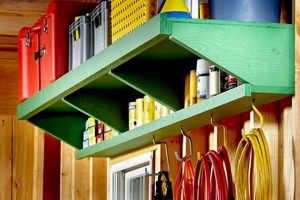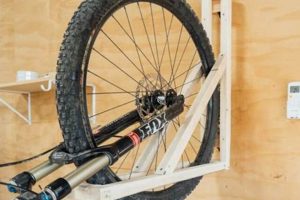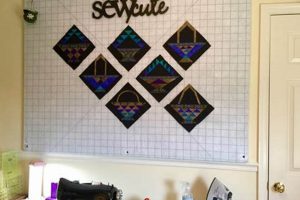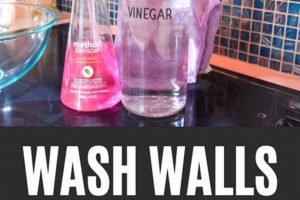The process of independently applying a textured finish to interior walls is an activity undertaken by homeowners and renters to alter the aesthetic appearance of a space. This activity involves utilizing various tools and materials to create patterns and depth on a wall surface, ranging from subtle to pronounced effects. For example, a person might use drywall compound and a trowel to achieve a specific texture, or a specialized roller to imprint a repeated design.
Applying textures offers several advantages, including concealing imperfections on wall surfaces, adding visual interest, and personalizing interior spaces. The practice of adding texture to walls dates back centuries, evolving from simple applications of natural materials like clay and lime to modern techniques utilizing specialized compounds and tools. This enhancement allows for a customized look that reflects individual style and preferences, contributing to a more comfortable and visually appealing environment.
The subsequent sections will delve into essential aspects of the activity. Topics include preparation, material selection, tool usage, application techniques, safety considerations, and relevant maintenance procedures involved in successfully altering the visual characteristics of vertical interior surfaces.
Essential Application Guidance
The following recommendations are designed to enhance the quality and longevity of textured wall finishes achieved through independent efforts. Adherence to these guidelines can mitigate common errors and promote professional-looking outcomes.
Tip 1: Priming is Paramount. Prior to applying any texturing material, ensure the wall surface is properly primed. A quality primer creates a uniform surface, promoting adhesion and preventing uneven absorption of the texturing compound. Failure to prime may result in inconsistent texture and potential delamination.
Tip 2: Compound Consistency is Critical. Maintaining consistent compound consistency is vital for uniform application. Carefully follow the manufacturer’s instructions for mixing drywall compound. Adjust the water content gradually, achieving a smooth, workable consistency similar to thick cake batter. Variations in consistency lead to uneven texture patterns.
Tip 3: Practice Makes Perfect. Before commencing work on the primary wall surface, practice the chosen texturing technique on a sample board or inconspicuous area. This allows for refining the application process, tool handling, and overall aesthetic before committing to the final surface.
Tip 4: Controlled Application. Apply texturing compound in a controlled manner, working in small, manageable sections. Over-application leads to excessive dripping and an uneven finish. Utilize appropriate tools for the selected texture, ensuring even distribution of the compound.
Tip 5: Proper Tool Selection. Choose the correct tools based on the desired texture. Sponges, trowels, brushes, and specialized rollers each create distinct effects. Experiment with different tools to achieve the intended visual outcome.
Tip 6: Adequate Drying Time. Allow sufficient drying time between coats and before painting. Premature painting traps moisture, potentially causing bubbling, cracking, or peeling of the textured surface. Refer to the manufacturer’s recommendations for specific drying times based on environmental conditions.
Tip 7: Ventilation is Vital. Ensure adequate ventilation in the work area during application and drying. This minimizes exposure to potentially harmful fumes and accelerates the drying process, leading to a more durable and consistent finish.
By carefully implementing these recommendations, individuals can significantly improve the quality and visual appeal of textured wall surfaces. Paying attention to these details minimizes errors and facilitates the creation of a durable and aesthetically pleasing finish.
The subsequent section will address frequently encountered problems and offer troubleshooting solutions to ensure a successful project completion.
1. Preparation
Thorough preparation constitutes a foundational element in the successful execution of wall texturing projects. Adequate preliminary measures significantly influence the quality, adhesion, and overall aesthetic of the finished surface. Insufficient preparation can lead to a range of issues, from uneven texture application to premature failure of the finish.
- Surface Cleaning and Repair
Prior to applying any texturing material, the wall surface must be meticulously cleaned to remove any contaminants, such as dust, grease, or loose paint. Furthermore, existing imperfections like holes, cracks, or damaged areas require repair. Failure to address these issues will result in an uneven texture and may compromise the long-term integrity of the application. For instance, applying texture over a dusty surface will prevent proper adhesion, leading to peeling and cracking over time. Similarly, neglecting to fill holes and cracks will result in visible imperfections in the finished texture.
- Priming
The application of a primer is a crucial step in preparing walls for texturing. Primer serves multiple purposes, including sealing the surface, promoting adhesion, and providing a uniform substrate for the texturing material. A quality primer creates a barrier that prevents the absorption of moisture from the texturing compound into the drywall, ensuring consistent drying and preventing issues like bubbling or cracking. Without primer, the texture may not adhere properly, leading to a substandard finish.
- Taping and Masking
Protecting adjacent surfaces from unwanted texture application is essential. This involves carefully taping off trim, ceilings, floors, and any other areas that should remain free of texture. Masking also prevents the need for extensive cleanup after the texturing process. Using high-quality painter’s tape and plastic sheeting ensures sharp, clean lines and prevents accidental application of texture to unintended areas. Inconsistent taping or masking can lead to a messy and unprofessional-looking result.
- Material and Tool Acquisition
Prior to commencing the texturing process, all necessary materials and tools must be readily available. This includes the texturing compound, primer, applicators (e.g., trowels, rollers, sprayers), buckets, mixing tools, and safety equipment. Having everything prepared and organized streamlines the process, minimizes disruptions, and ensures that the work can be completed efficiently and effectively. A lack of proper preparation in this regard can lead to delays and frustration during the application process.
In summary, preparation forms the bedrock of any successful independent wall texturing endeavor. By meticulously cleaning and repairing surfaces, applying primer, taping and masking appropriately, and ensuring all materials and tools are readily available, individuals can significantly enhance the quality, durability, and aesthetic appeal of their textured wall finishes, avoiding common pitfalls associated with inadequate preliminary measures.
2. Material Selection
The choice of materials in independently executed wall texturing significantly influences the final appearance, durability, and ease of application. Appropriate selection is essential to achieve the desired aesthetic and ensure a long-lasting finish. The following details highlight key considerations in material selection for wall texturing projects.
- Texturing Compound Type
Various texturing compounds are available, each offering distinct properties and suitability for different texture styles. Options include joint compound (drywall mud), pre-mixed texture compounds, and specialized products designed for specific effects (e.g., orange peel, knockdown). Joint compound is versatile but requires mixing and may shrink during drying. Pre-mixed compounds offer convenience but may be less adaptable. Selecting the appropriate compound based on the desired texture and skill level is critical. For example, a novice might find pre-mixed knockdown texture easier to apply than attempting to create a swirl texture with joint compound.
- Primer Selection
The choice of primer impacts adhesion and the overall performance of the textured surface. Oil-based primers provide excellent adhesion but require longer drying times and more rigorous cleanup. Water-based primers are easier to apply and clean, but may offer less robust adhesion on certain surfaces. Consider the existing wall surface and the type of texturing compound being used when selecting a primer. Improper primer selection can lead to peeling or cracking of the texture over time. Using a bonding primer on glossy surfaces is crucial to ensure adequate adhesion of the texturing material.
- Sealer and Paint Compatibility
Following texture application, a sealer is often applied to protect the surface and prepare it for painting. Compatibility between the sealer, paint, and texturing compound is essential to prevent adverse reactions such as blistering or discoloration. Latex paints are generally compatible with most textured surfaces and sealers. However, solvent-based paints may react negatively with certain compounds. Always test a small, inconspicuous area to ensure compatibility before applying the sealer or paint to the entire surface. Failure to do so can result in costly and time-consuming repairs.
- Tool Material Considerations
While not a direct component of the wall itself, the materials used to construct application tools (trowels, rollers, sprayers) impact the final texture. Trowels with flexible blades allow for smoother application of knockdown textures, while stiff-bladed trowels might be preferable for creating more aggressive textures. Rollers with varying nap lengths produce different stipple effects. Selecting the appropriate tool materials can improve application efficiency and the quality of the finished texture. Using a worn or damaged tool can result in an uneven and unprofessional-looking texture.
In conclusion, appropriate material selection is a fundamental aspect of independently texturing walls. Consideration of the texturing compound, primer, sealer, paint, and application tool materials directly influences the success of the project. A thorough understanding of the properties and compatibility of these materials empowers individuals to achieve a durable, aesthetically pleasing, and long-lasting textured wall finish.
3. Technique
The application technique forms a critical juncture in the process of independently texturing walls. It dictates the aesthetic outcome and the practicality of achieving a desired effect. The chosen method must align with the selected materials and the existing skill level to ensure a successful implementation.
- Application Method
The specific application method directly influences the texture’s appearance and uniformity. Methods include spraying, troweling, rolling, and stippling, each producing a distinct visual result. For example, a hopper gun sprays a consistent pattern for orange peel texture, while a trowel creates a smooth, layered effect in Venetian plaster. The appropriate method depends on the chosen texture and the desired level of control. Inconsistent application results in unevenness and detracts from the finished appearance.
- Pattern Consistency
Maintaining consistent pattern application is crucial for a cohesive and professional result. This requires a steady hand, consistent pressure, and a clear understanding of the desired pattern. Overlapping or uneven application of texture can create unsightly variations. For instance, when applying a knockdown texture, consistent pressure on the trowel is essential to achieve a uniform flattening of the peaks. Practice on a sample board is advisable to refine consistency before applying the texture to the entire wall.
- Layering and Depth
Layering techniques can add depth and complexity to a textured wall. Applying multiple thin layers of texture, rather than a single thick layer, allows for greater control over the final appearance. This approach is particularly useful for creating intricate textures or for concealing imperfections in the wall surface. For example, a layered approach may be used to create a subtle, undulating texture that mimics the look of natural stone. Improper layering can lead to cracking or peeling of the texture.
- Tool Manipulation
Proficient tool manipulation is essential for achieving the desired texture. Different tools require varying levels of skill and control. A trowel requires precise angling and pressure to create smooth, consistent textures. A sprayer requires consistent distance and speed to achieve a uniform pattern. Familiarity with the chosen tools and techniques is critical. Poor tool manipulation leads to uneven texture, visible tool marks, and an overall unprofessional finish.
The described facets of technique underscore their vital role in independently texturing walls. The choice of application method, maintenance of pattern consistency, layering for added depth, and adept tool manipulation are intertwined with the visual and tactile qualities of the finished surface. Mastering these aspects through practice and informed decision-making is essential for achieving professional results.
4. Tool proficiency
Success in wall texturing is significantly linked to the operator’s mastery of the tools involved. Lack of proficiency directly correlates to diminished quality in the final texture, increased project completion time, and potential material wastage. For instance, attempting to create a knockdown texture with improper trowel angling results in inconsistent flattening and an unprofessional appearance. Similarly, inexperience with a texture sprayer can lead to uneven material distribution, creating drips and an unappealing surface. Therefore, tool proficiency forms a foundational element for effective execution.
The impact of tool proficiency extends beyond mere aesthetics. Proper handling minimizes material consumption and reduces the risk of surface damage. An experienced operator understands the nuances of each tool, adjusting techniques to suit the specific texture and compound. This adaptability prevents common problems such as excessive build-up, air pockets, or inadequate adhesion. An example is the subtle adjustment of air pressure on a texture sprayer to achieve the desired orange peel effect, showcasing a direct application of skilled tool operation.
Ultimately, tool proficiency in independently executed wall texturing ensures a balance of aesthetic quality, material efficiency, and project longevity. Inadequate skill poses considerable challenges, potentially leading to unsatisfactory results and increased costs. A clear understanding of each tool’s function, coupled with practical experience, is essential for navigating the complexities of wall texturing and achieving a professional-grade finish. Addressing this aspect mitigates risks and contributes significantly to the overall success of the undertaking.
5. Safety Measures
The incorporation of stringent safety measures is paramount in the context of independently executed wall texturing projects. This is due to inherent risks associated with materials, tools, and environmental factors. Failure to adhere to recommended safety protocols can lead to adverse health effects, injuries, and property damage. The link between safety measures and activity success is direct; proper precautions mitigate potential hazards, thus facilitating a safer and more efficient completion of the project. For instance, neglecting to wear a respirator while spraying texture compound increases the risk of inhaling particulate matter, leading to respiratory irritation or long-term health problems. Similarly, failing to use appropriate eye protection exposes individuals to the risk of chemical splashes or projectile debris.
Effective safety measures encompass several key areas: adequate ventilation to minimize exposure to airborne particles and chemical fumes, the use of personal protective equipment (PPE) such as respirators, gloves, and eye protection, and proper handling and disposal of materials. Furthermore, awareness of potential electrical hazards is crucial, especially when operating power tools or working near electrical outlets. A practical application of this understanding involves thoroughly reading and understanding the Material Safety Data Sheets (MSDS) for all products used, ensuring compatibility and awareness of potential hazards. Additionally, maintaining a clean and organized workspace minimizes the risk of slips, trips, and falls.
In summary, the diligent implementation of safety measures is an indispensable component of independently texturing walls. It not only safeguards the health and well-being of the individuals involved but also contributes to the overall quality and success of the project. Neglecting these precautions can result in significant risks, emphasizing the importance of integrating safety protocols into every phase of the endeavor. A commitment to safety mitigates potential hazards, facilitating a smoother, more efficient, and ultimately more rewarding wall texturing experience.
6. Finishing
Finishing represents the concluding phase of independently executed wall texturing projects, encompassing processes that enhance the aesthetic appeal, durability, and longevity of the textured surface. This phase necessitates careful execution as it directly impacts the final visual impression and long-term performance of the walls.
- Sealing Application
The application of a sealer acts as a protective barrier, guarding the textured surface against moisture, stains, and physical abrasion. Sealers also prepare the surface for subsequent painting, ensuring uniform adhesion and preventing uneven absorption of paint. For instance, applying a quality acrylic sealer over a textured drywall surface prevents moisture from penetrating the porous texture, reducing the likelihood of mold growth and prolonging the life of the finish. Incomplete or uneven sealing can lead to water damage, staining, or peeling of the paint layer.
- Painting Techniques
The chosen painting technique significantly influences the final appearance of the textured wall. Techniques such as rolling, brushing, or spraying can create different effects, accentuating or minimizing the texture’s depth and detail. For example, using a high-nap roller on a heavily textured surface ensures that paint reaches all crevices, resulting in consistent color coverage. Conversely, a low-nap roller may be preferable for smoother textures, minimizing paint build-up and preserving the subtle details. Incorrect painting techniques can obscure the texture or create an uneven and unprofessional-looking finish.
- Color Selection Considerations
Color selection plays a pivotal role in accentuating or downplaying the texture’s characteristics. Lighter colors tend to make textures appear more pronounced, while darker colors can create a more subdued effect. Gloss levels also influence the visual impact; high-gloss paints reflect more light, highlighting imperfections, while matte finishes tend to conceal them. For instance, a light, matte color might be chosen to enhance the rustic appeal of a heavily textured wall in a farmhouse-style interior. Failure to consider the interplay between color and texture can result in an undesirable aesthetic outcome.
- Surface Protection and Maintenance
Post-painting surface protection measures are crucial for maintaining the longevity and appearance of the textured wall. This includes avoiding abrasive cleaning products, promptly addressing any damage or stains, and implementing preventive measures to minimize wear and tear. For example, using a soft cloth and mild detergent to clean textured walls prevents scratching and maintains the integrity of the painted finish. Neglecting routine maintenance can lead to deterioration of the texture and the need for costly repairs or reapplication.
The successful integration of sealing, painting, color considerations, and ongoing maintenance culminates in a durable and aesthetically pleasing textured wall finish. Each of these facets is essential for maximizing the benefits of independently executed wall texturing, ensuring that the final product meets expectations and provides long-lasting visual appeal.
Frequently Asked Questions About Independently Texturing Walls
The following questions address common concerns and misconceptions related to the independent application of textured finishes to interior walls. These answers are designed to provide clarity and facilitate informed decision-making regarding this undertaking.
Question 1: Is specialized expertise necessary to achieve a professional-looking textured wall finish?
While specialized expertise can enhance the quality and efficiency of the process, it is not strictly necessary. Individuals with basic DIY skills and a willingness to learn can achieve satisfactory results through careful preparation, practice, and adherence to established techniques. However, complex textures or large-scale projects may benefit from professional assistance.
Question 2: What is the typical lifespan of a textured wall finish, and what factors influence its longevity?
The lifespan of a textured wall finish varies depending on the quality of materials used, the application technique, and the level of maintenance. Generally, a properly applied and maintained textured finish can last for several years. Factors that influence longevity include moisture exposure, physical abrasion, and the use of appropriate cleaning products.
Question 3: Can existing textured walls be smoothed over, and what is involved in this process?
Yes, existing textured walls can be smoothed over. This process typically involves applying a skim coat of joint compound to fill in the texture, sanding the surface smooth, and then priming and painting. The number of skim coats required depends on the depth and aggressiveness of the existing texture.
Question 4: Are there any specific safety precautions that must be observed when independently texturing walls?
Yes, several safety precautions are essential. These include ensuring adequate ventilation to minimize exposure to airborne particles and fumes, using personal protective equipment such as respirators, gloves, and eye protection, and properly handling and disposing of materials. Awareness of potential electrical hazards is also crucial.
Question 5: What are the most common mistakes made when independently texturing walls, and how can they be avoided?
Common mistakes include inadequate surface preparation, inconsistent application of texture, improper mixing of materials, and failure to allow sufficient drying time. These can be avoided by carefully cleaning and priming surfaces, practicing application techniques, following manufacturer’s instructions for mixing materials, and adhering to recommended drying times.
Question 6: Does texturing a wall increase its insulative properties, and to what extent?
Texturing a wall provides a negligible increase in insulative properties. The primary purpose of texturing is aesthetic enhancement, not thermal insulation. For significant improvements in insulation, consider adding insulation materials within the wall cavity.
In conclusion, independent wall texturing requires careful consideration of technique, materials, and safety. Approaching the task with a well-informed perspective maximizes the likelihood of a successful and aesthetically pleasing outcome.
The next section will transition to a discussion of troubleshooting common problems encountered during wall texturing and present practical solutions.
Conclusion
The preceding analysis has explored facets of independently texturing walls, emphasizing preparation, material selection, technique, tool proficiency, safety measures, and finishing procedures. Each element contributes significantly to the overall outcome, affecting the aesthetic appeal and long-term integrity of the finished surface. A comprehensive understanding of these aspects is crucial for successful project execution.
Therefore, prospective individuals should carefully consider the discussed principles and practical applications to enhance their skills and mitigate potential challenges. Informed application of these insights will foster proficient and reliable textured wall finishes, contributing to the overall quality and value of interior spaces.







